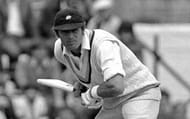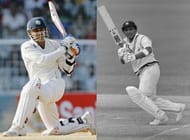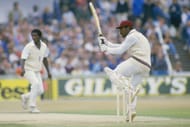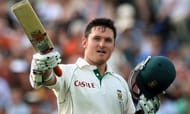A retirement isn’t something that should come out of the blue. A retirement should be hinted at in advance, planned meticulously and taken graciously. For a player who spent 13 odd years keeping Indian cricket at the top, a retirement should be more than a surreptitious remark.
But that’s how it might end for Virender Sehwag, one of India’s, and the world’s, most destructive batsmen. But Sehwag's retirement is all set to happen, when the nation is still coming to terms with another major retirement this week, that of Zaheer Khan.
After Indian skipper Sourav Ganguly and Coach John Wright put their heads together in 2001, the plan that sprouted up was that Sehwag should open the batting in Tests. Sehwag had earlier hit a century off 69 balls against Sri Lanka in an ODI, and this prompted the sudden brainwave.
It turned out to be a masterstroke as he made 105 on debut against the rampaging South Africans. His next big score would only come almost a year later, but he was still persisted with, and it paid off big time. He scored a century in England and two more in India as his fame grew in leaps and bounds.
His 195 in Melbourne was an act of audacity, and it started a period where Sehwag scored an unimaginable 11 consecutive centuries of 150 runs or more each. With his first triple century in Multan, Sehwag became India’s highest scorer in tests, a record he would go on to beat.
He was one of the first players who proved that strike rates were important in Test matches also, as he went on change the face of a match in just a session or two. His hard hitting and stand-and-deliver style are unmatched, and India will never see a player of his like again.
Here, we compare Virender Sehwag to former greats who opened the batting in Tests, and see where he ranks among the best:
Career Numbers
| Player | Matches (as Opener) | Runs | Average | 100/50s | Best |
| Virender Sehwag | 99 | 8207 | 50.04 | 22/30 | 319 |
| Sunil Gavaskar | 119 | 9607 | 50.29 | 33/42 | 221 |
| Gordon Greenidge | 107 | 7488 | 45.10 | 19/34 | 226 |
| Geoff Boycott | 107 | 8091 | 48.16 | 22/42 | 246* |
| Matthew Hayden | 103 | 8625 | 50.73 | 30/29 | 380 |
| Graeme Smith | 114 | 9030 | 49.07 | 27/36 | 277 |
Sehwag’s overall numbers put him right up there in the list of highest runs scored by an opener in Test matches. Sehwag currently occupies the fifth position, and it is set to hold it for a long time.
Sehwag has 8207 runs in 99 matches as an Indian opener, at a tremendous average of 50.04. Heading the list of most runs by an opener is Sunil Gavaskar, the first man to score 10000 runs in Test cricket. He was one of India’s earliest legends, and his feats against the World Champions West Indies are monumental, to say the least. It would not be amiss to say that India has never had a better opener apart from Sehwag and Gavaskar.
Graeme Smith finished second on the list, with 9030 runs in 114 matches. His ability to play his shots on hard, bouncy wickets around the world made him a terrific batsman to rely on, and he consistently performed for South Africa. He narrowly missed out on being South Africa’s first triple-centurion – getting out for 277 – but he had cemented his place in the team.
Geoff Boycott is another yesteryear legend, who led the charts as England’s top run-scorer for a long time. He was a prolific opener who could bat for long periods of time and hit timely centuries. His twin centuries in the 1971 Ashes helped England beat Australia 2-0, and he finished with 657 runs at 93.85.
Gordon Greenidge could have well been a precursor to Virender Sehwag. They had similar styles of batting, going all out in destroying oppositions and scoring at a maniacal pace. Greenidge didn’t believe in running between the wickets as he walloped and blazed his way to 19 centuries, including two double centuries in a single series. With Desmond Haynes, he formed the most successful opening partnership in Tests, a record that still stands.
A batsman of similar mould was Matthew Hayden, who scored 8625 runs in 103 matches. While he could go big and long when he wanted to, Hayden played orthodox cricket in the longer format of the game. Preferring to stroke the ball around than lash it, he compiled several quiet centuries over his career. But he could be severe when he wanted to, as he threatened to make Test cricket’s first ever 400, but got dismissed for 380 against Zimbabwe.
In The Subcontinent
| Player | Matches (as opener) | Runs | Average | 100/50s | Best |
| Virender Sehwag | 65 | 6091 | 58.56 | 18/22 | 319 |
| Sunil Gavaskar | 74 | 5739 | 49.47 | 18/27 | 205 |
| Gordon Greenidge | 20 | 1222 | 37.03 | 3/5 | 194 |
| Geoff Boycott | 8 | 706 | 58.83 | 2/5 | 105 |
| Matthew Hayden | 19 | 1663 | 50.39 | 4/8 | 203 |
| Graeme Smith | 21 | 1705 | 50.14 | 4/7 | 234 |
In the subcontinent, Sehwag stands heads and shoulders above the rest, even above Gavaskar. Having playing more than 60% of his matches there, it is no surprise to see him score 6091 runs in 65 games. His average of 58.56 is spectacular, but what really makes him the best is his fifty-to-hundred conversion rate.
Gavaskar comes second with 5739 runs in 74 games but still falls short of Sehwag. Though he has made an equal number of centuries, Gavaskar has slightly more fifties than him. Quite surprisingly, Gavaskar’s average in the subcontinent is lesser than his overall average, which only proves how good he was overseas.
Greenidge’s average is substantially lowered due to his poor outing in Pakistan, where he only managed 180 runs in six matches. He performed far better in India, scoring at 45.30 in 14.
Geoff Boycott had a terrific outing in both India and Pakistan, picking up seven scores of 50 or more in 15 innings. He enjoyed Pakistan more, though, as he scored 329 runs in three matches against them.
Matthew Hayden’s best opposition have also been Pakistan, scoring 246 runs in 3 matches. But the team he performed the most consistently against was India, scoring a century and five fifties in 11 matches.
Graeme Smith’s subcontinent career is perhaps the most curious. He has double centuries against Bangladesh and Pakistan, but only has the highest score, which is in the 70s against Sri Lanka and India.
In fact, among the players who have played in Sri Lanka, Sehwag has the highest average among them, with 69.20. Sehwag has also scored the most centuries against them, with 5 in the subcontinent. The only team he has failed to score a century in the subcontinent is Bangladesh, against whom he has only played six matches.
Sehwag also has the highest average in Pakistan – 103.85, courtesy a double and a triple century. Most astonishingly, Sehwag has a strike rate of 80.00 and above against every team except Australia, against whom he just falls short at 77. This is what made Sehwag so dangerous during his time.
Away from the Subcontinent
| Player | Matches (as opener) | Runs | Average | 100/50s | Best |
| Virender Sehwag | 34 | 2116 | 35.26 | 4/8 | 195 |
| Sunil Gavaskar | 45 | 3868 | 51.57 | 15/15 | 221 |
| Gordon Greenidge | 87 | 6266 | 47.11 | 16/29 | 226 |
| Geoff Boycott | 99 | 7385 | 47.33 | 20/37 | 246* |
| Matthew Hayden | 84 | 6962 | 50.81 | 26/21 | 380 |
| Graeme Smith | 93 | 7325 | 48.83 | 23/29 | 277 |
It is on overseas conditions that Sehwag comes up a little short. He has excellent averages in Australia and West Indies – with 46.86 and 51.00 respectively but has averages of below 28.00 in other nations.
His away average of 35.26 is much lower than his overall average. It is also where Sunil Gavaskar asserts his position as a batting legend. His average away is more or less the same as his overall average, which suggests his ability to bat on even the most treacherous of conditions. Gavaskar had an average of 40.00 against all overseas team, and centuries against them all.
Gordon Greenidge loved playing against England, boasting an average of above 50.00 both in and against them. It is in Australia that his average drops to 30.96.
Geoff Boycott was something of an Ashes specialist, and his average of 46.05 in 34 Ashes tests proves it. He had excellent outings against subcontinent teams at home, scoring 707 runs in eight matches against India and 262 in three matches against Pakistan.
Matthew Hayden’s average also remains constant outside the subcontinent, and his numbers prove his worth. He has an average of above 40.00 against most major teams. He is curiously found lacking against Pakistan, against whom he only has 128 runs in six innings, with no centuries and a fifty.
Graeme Smith’s record in tough conditions speaks for itself, as he has an above 40.00 average in all overseas countries. Especially in the swinging conditions of England, he averages 67.75 in 12 matches, with five centuries and three half-centuries.

Sehwag seems to prefer batting first, as his average touches 50.52 in matches where India have won the toss and batted. All his centuries have also come when India have batted first.
Sehwag’s fourth innings average of 27.55 is the lowest among all the batsmen, Sunil Gavaskar having the highest of 75.69. Curiously, Sehwag has no centuries in India’s overseas wins but has three in draws and one in a loss.
Much like Gavaskar, Sehwag has a good record in West Indies, with 357 runs in four games. Another quirky fact is that Graeme Smith has actually hit more sixes than Sehwag overseas, with 18 to Sehwag’s 17. The Indian opener easily leads the list overall, with no less than 91 sixes in Test cricket.
In Victories
A batsman’s worth can be determined by how much he has helped his team win a match. Even if personal milestones are achieved every match, it does not mean a thing unless the team has won the match. Let’s look at how the openers have fared when their team has won:
| Player | Matches (as opener) | Runs | Average | 100/50s | Best |
| Virender Sehwag | 41 | 3424 | 54.34 | 8/15 | 309 |
| Sunil Gavaskar | 22 | 1597 | 43.16 | 6/6 | 166 |
| Gordon Greenidge | 57 | 4643 | 55.27 | 14/18 | 226 |
| Geoff Boycott | 35 | 2950 | 54.62 | 10/10 | 246* |
| Matthew Hayden | 71 | 6154 | 55.44 | 23/19 | 380 |
| Graeme Smith | 59 | 5171 | 62.30 | 18/20 | 259 |
After the significantly poor numbers overseas, Sehwag is back on track with his record in wins. His average shoots back up to 54.34, with eight centuries and 15 fifties in 41 matches. He has led India to several victories in the subcontinent, especially in crucial matches against Sri Lanka.
His knocks of 309 against Pakistan and 201* against Sri Lanka are one of the best innings by an Indian batsman. Gavaskar has relatively been quiet in India’s wins, his averages falling below his overall numbers. But he still has impressive stats, with six centuries and six fifties in 22 matches.
Gordon Greenidge has an excellent conversion rate, with 14 centuries and 18 half-centuries in 57 matches. He has been especially prolific in England, with 1329 runs in 12 wins.
Geoff Boycott averages 54.62 when England won, with centuries against every major team except South Africa. He had a particularly good time against India, against whom he averaged 85.50.
Matthew Hayden led Australia to victories against several teams, averaging above 40.00 against most of them. His lowest was against New Zealand, with only 25.00 in 7 games. The year 2003 was Hayden’s peak, as he scored 939 in 8 games, at an average of 104.33.
Graeme Smith’s average in wins is also much higher than his overall average, as it rises to 62.30. Smith has been at his best in South Africa, scoring at 54.50 and in England, scoring at 81.37. He also has centuries against all major teams excepting India, thanks to the wily Zaheer Khan. Smith averages more than 50.00 in every continent that he has played in, which is no mean feat.
Sehwag’s averages in home and away wins are more or less the same, which shows his contribution to India’s victories in all sorts of conditions. His best year came in 2009, as he scored 448 runs in three wins, including 293 in Mumbai. It was after he scored 728 runs in six wins in 2008, and his feats in the two consecutive years helped India to the Number 1 spot in the ICC Test rankings soon after.
Once again, Sehwag’s strike rate stands supreme, as he has more than 80 against every team except Australia. His penchant for scoring quick runs was especially useful in Chennai 2008, as he scored a quick-fire 83 to help India chase down 387 against England.
But once again, Matthew Hayden takes the prize for most sixes in wins, scoring 51 to Sehwag’s 50. Sehwag is undoubtedly at his best in the first innings, averaging 64.22, when compared to just 37.17 in the second innings. He has been especially prolific in the Border-Gavaskar Series, contributing 602 runs in nine victories, with four half-centuries.
Final Say
Once Gavaskar’s reign ended, India was looking for another opening superstar. The West Indies had Greenidge, England had Boycott and Australia had Marsh, Boon and then Hayden.
India was still looking for that one man who could change a match with his batting at the top of the order. Thanks to Sourav Ganguly, they got Virender Sehwag. Making a name for himself with his big hitting, Sehwag quickly made giant strides in Tests, scoring a century on debut. He followed it up with a 130 in Mohali, a 195 in Melbourne and then the mighty 309 in Multan. India had got themselves an opener, and Sehwag was set to be one of the best.
It is usually when cricketers are under pressure that they fail. But Sehwag thrived under pressure. He made it his business to get big hundreds, with another famous 254 against Pakistan and then his second triple, a 319 against the dangerous South Africans.
He also played the innings of his life in Galle, scoring 201* and carrying the bat as India won the match to square the series 1-1. He almost became the first man in the history of the game to score three triple-centuries but fell an agonizing seven runs short, victim to his own aggressive tendencies.
Between the match-winning centuries were crucial stands also – his 83 against England in Chennai being a prime example of how a quick start can change a game on its head. His 151 in Adelaide, still his only fourth innings century, proved that he could bat when the chips were down, and he salvaged a face-saving draw for India. Even though a bulk of Sehwag’s centuries only ended in draws – 12 out of 23 – he is still remembered as India’s best ever entertainer.
Standing 5th in the list of highest runs scored by an opener in tests, Sehwag looks set to stay there for a while. As he is set to announce his retirement from international cricket, the world is poorer for it. India will miss his fiery starts and boundaries to reach centuries, as Sehwag fades as one of India’s best ever openers.
Brand-new app in a brand-new avatar! Download CricRocket for fast cricket scores, rocket flicks, super notifications and much more! 🚀☄️




